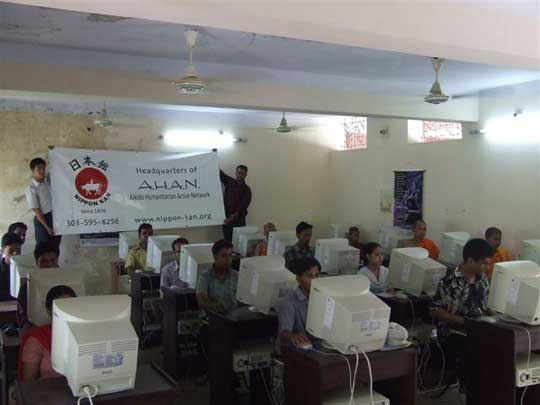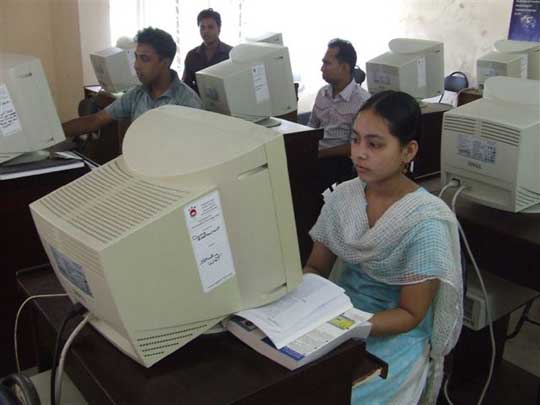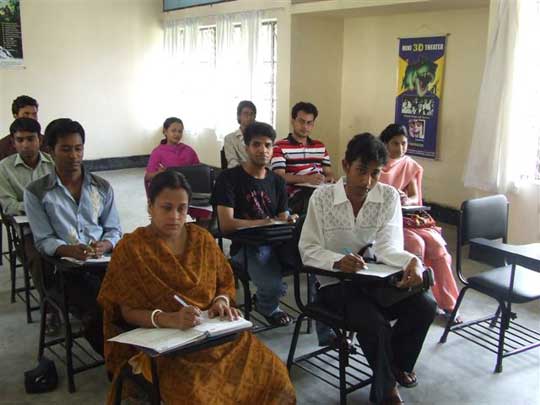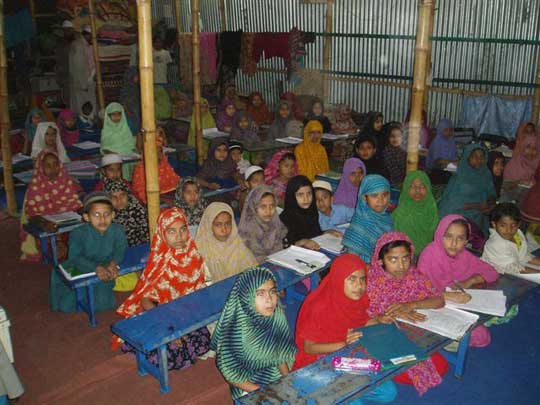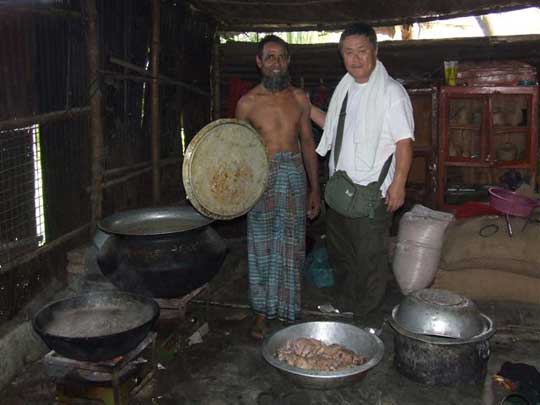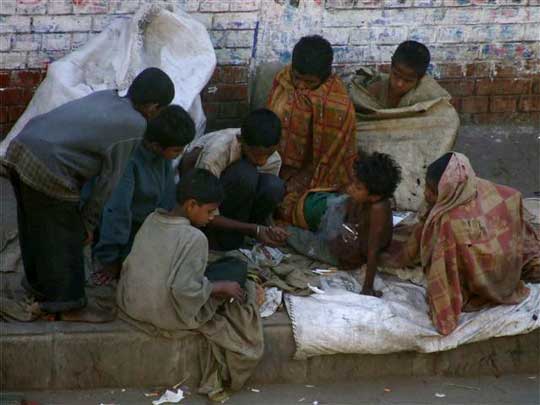
There is nothing again today for these children as the sun rises over the streets of Dhaka, Bangladesh.
I will never forget that child. The sound of his voice and his image will always remain in my memory. His voice was high like a child’s but from blocks away you could hear the distress in his tone. I could hear his voice above the din of the crowded streets of Dhaka. Riding in a rickshaw, we passed a corpse on the sidewalk that was hastily covered,waiting for the untouchables to take him away. From my seat I searched for the child whose voice I heard but I could not see him. The voice grew nearer and suddenly I saw him. The sight of him surprised me so that I grabbed the shoulder of the rickshaw driver peddling in front of me. He looked back at me startled and stopped the rickshaw. He was surprised by my reaction, not by what had surprised me.
Before me was an old dilapidated wooden flatbed cart. The flatbed was covered with a thin straw mat. A boy lay on the mat. He had no arms and no legs. The voice I had heard above the crowds was from this small boy. A few passersby threw coins onto the mat where the boy lay and were quickly snatched up by someone waiting nearby.
***
The lane marking the edge of the marketplace was lined with large metal trash bins. As we passed by the marketplace I heard voices coming from inside the large trash containers filled with garbage. Days of rain had turned the trash into a muddy, soggy mash of waste. There were naked children in the bins, picking through the sodden trash for something worth salvaging. They dove face deep into the trash to retrieve small pieces of metal and plastic which they delivered to possibly their mother who waited nearby.
***
We turned from the marketplace back on to the main thoroughfare where people, a few even clad in suits, walked swiftly by. I heard the sound of a baby crying. I looked around but could not see any children nearby. We passed an intersection and there in the gutter was a baby lying on a newspaper without even a diaper on. People walked by apparently unaffected by the sight of a baby lying in the street crying. The baby I believe was a lure for those passing by to leave a dollar or two.
This is a true story about what I saw on a 20-minute rickshaw ride through the streets of Dhaka during my first visit to Bangladesh. It shocked and scared me that first day, but after seeing sights like this day after day, my sense of shock, horror and sadness started to disappear. It scared me even more that I could get used to seeing the human conditions around me. I questioned my own sense of humanity, but slowly came to realize that reacting in shock or horror or anger at a society that could condone these kind of conditions were actually the reactions of a beginner in Bangladesh. I soon learned that to be an effective humanitarian activist in this country, I would have to take a step back and view the overall human social structure without so much emotion.
I was learning that I had to consider the customs, social structure, and values of the adults in the community to gain a balanced perspective. If I were to somehow take the boy out of the cart, or put hundred dollar bills in the trash for the children it would not cause lasting change in their circumstance. To play “Santa Claus” for one day without considering all the factors was not a long-term solution, and might even cause more problems on the short run.
***
I have been serving meals to the homeless in Denver for the past 17 years. Friends and associates of mine have sometimes joined me for the monthly meal service at the Denver Rescue Mission. Most of my guests are not accustomed to spending time with the homeless, and react emotionally while serving the usual 300 evening meals. Sometimes I have seen them cry. I think these friends of mine shed tears not only out of compassion for those less fortunate, but also tears of gratitude and appreciation for the happiness in their own lives.
When I started serving meals to the homeless I too reacted with many emotions and wrote many articles about how I felt. Now when I read these old articles I realize that I do not feel the same anymore, nor do I react the way that new friends do when they come to the shelter for the first time. Today I have no deep emotional reaction to the people I meet at the shelter. I see now with a calmer eye and am able to look at the bigger picture of the problems and situations that brought these people here. I think now that it takes getting over the initial emotional reactions of shock or pity to be able to truly understand their situation and find a direction towards a possible solution. This feeling of calm is the feeling I think true martial artists have before engaging with a partner or an opponent. One needs to step back emotionally to find a place of calm before reacting with action. This is the concept of “mu” or a state of nothingness. It is the same place I have reached at the homeless shelter.
Some of the places I travel to worry my staff. I think I am able to go places that others might seem dangerous or difficult because I have been able to step back emotionally when I visit new places and not react from pure emotion. I am aware of my responsibilities to my businesses back home and am aware of the risks of getting sick or having an accident, but I have prepared myself for emergencies in the most responsible ways possible.
***
If there is a large accident or natural disaster, emergency relief workers on the scene first organize the victims by degree of severity of injury using a triage system consisting of four categories: BlACK, RED, YELLOW and GREEN. The BLACK LEVEL is reserved for those that have passed away or are beyond assistance; the GREEN LEVEL on the other end of the spectrum is the level for those victims with the least traumatic injuries.
AHAN (Nippon Kan’s Aikido Humanitarian Active Network) has grown since its inception in 2001 and we have all learned much from our experiences both good and bad around the world. About a year ago, Nippon Kan General Headquarters decided that AHAN’s projects needed a similar emergency triage like system. This system for all upcoming AHAN projects will be implemented beginning in 2008.
The following explanation of this AHAN triage system might sound alarming or cold to other humanitarian activists, but I encourage you to read the entire article and try to understand the underlying purposes in these systems as a way to be the most effective in our plans for assisting others around the world in the future. AHAN is a small organization with limited resources. Effective organizing can go a long way towards effective results.
At the beginning of this article I described children in Bangladesh in such dire misery as to bring a tear to one’s eye. This level of plight falls into the BLACK LEVEL CATEGORY. The people at the homeless shelter in Denver fall into the GREEN LEVEL CATEGORY.
First I will explain why the homeless in Denver fall into the GREEN LEVEL CATEGORY. A big reason is because they have A VOICE. They have the power to appeal to society for solutions to their problems and there are governmental and social resources available to assist them. Their situation is a social and political one that does get attention. On the other end of the spectrum, those in the BLACK LEVEL CATEGORY have NO VOICE. There is no one that speaks for these people and they themselves might not even know that there are others ways to live. Their condition is so bad that they do not have any hint of the capability of the human condition. It is very sad to think of those in the BLACK LEVEL CATEGORY, but if we are thinking of effective assistance, it is better to focus aid on the people in the RED and YELLOW CATEGORY. Here is why.
Looking at the problems long term, we can help best by focusing on the future of the children (and adults) in the RED and YELLOW CATEGORIES. There is a better chance for these children and adults to be able to help themselves and in turn possible to help other in worse conditions.
When we began the AHAN support projects in Bangladesh we received many emails from other organizations beseeching us for help. “The conditions in the orphanages you support are good compared to ours; we need much more help than they…” and “Don’t give your help to these orphanages, give your funds to me! I will give them to the most in need…” Both types of letters were a surprise to us, and we may have just misread the English wording in some of these requests for aid. AHAN Bangladesh staff is researching these other operations requesting assistance just to make sure. I think what some of what these letters were stating is true; there are other organizations out there in dire need of help. These organizations however still have the ability to speak for themselves. They even write emails to the United States asking for assistance. They have a voice to speak for them, so in the AHAN triage system they would fall in the YELLOW LEVEL CATEGORY. In a medical emergency triage system as well, victims conscious and able to verbalize their injuries fall into a YELLOW LEVEL CATEGORY. Victims in the GREEN and YELLOW LEVEL CATEGORIES have the possibility of support by government and other humanitarian organizations.
AHAN International Project Director, Emily Busch traveled to Bangladesh in July 2006 and visited the NGO (Non profit organization) Ministry to get permission to open a small bank account for humanitarian project distribution in AHAN’s name. The Director of the Ministry himself asked her how much money she could give to him! We have discovered that humanitarian and social service organization in Bangladesh is plagued with corruption and other dysfunction which adds to the overall problems there like in so many other countries.
AHAN has projects that involve many category levels, but we have found that we can best support organizations that are having an extremely difficult time, and do not have the experience or understanding of fundraising or procuring assistance to ask for help from other organizations. In other words, these groups are in desperate need of assistance, and cannot speak for themselves. In a medical emergency triage system, victims in full trauma who cannot speak for themselves fall into the RED LEVEL CATEGORY.
AHAN has limited resources, but we have found that the small support we can offer really benefits organizations that have meager facilities but cannot appeal for help from other organizations. These are the organizations that are others can’t reach, yet with a little help can provide food, shelter and education for those in their care. Successful assistance at the RED CATEGORY LEVEL requires us to have trusted local staff members on the scene to supervise aid delivery, constant communications and visits from AHAN Headquarters. It is most important not only to learn to pick up broken glass underfoot, but to educate not to break glass bottles in the first place. If we focus on educating the next generations of social leaders in the YELLOW AND RED LEVEL CATEGORIES, they can in turn help the children who make their existence picking through the trash in dumpsters. Finally, it is our hope that a small gift of aid will benefit all levels, not just one. Making new leaders from those in the YELLOW and RED LEVEL CATEGORIES is beneficial because these young people have a real-life understanding of the problems of those in severe need. Children in the orphanages we are currently assisting will make the best future leaders with the education and guidance they are now receiving; they will have the best chance to change their conditions in the future.
A successful example of AHAN’s triage system philosophy is evident in my most recent visit to Bangladesh. I came to Bangladesh, October 1st, 2007 for the second time this year to supervise the ordering of emergency flood relief supplies for the Madrasah Orphanage for girls. On this visit I stopped at the Dharmarajika Orphanage for boys to check on how the 40 used computers delivered earlier this summer were being put to use.
The Dharmarajik Orphanage is part of a large Buddhist Temple complex that operates a private school and a denim factory; therefore they do have their own sources of income and assistance. As a fairly independent facility they are a GREEN LEVEL CATEGORY facility in the AHAN triage system.
AHAN supports this GREEN LEVEL CATEGORY facility because the Dharmarajika Orphanage cares for over 500 boys under their religious guidelines. Even though they are GREEN LEVEL and there are others less fortunate, these children are very important to the future of Bangladesh. We are supporting their care and education to promote not only their own futures but the future of all other levels of care in Bangladesh. We cannot reach out to everyone today, but by reaching out to the Dharmarajika Orphanage, others will have a chance in the future. We offer our support to this GREEN LEVEL facility in support of ALL levels in the future.
The Dharmarajika Orphanage has a medical staff made up of doctors, nurses and assistants that are Hindu, Muslim, Buddhist and Christian. The leaders of the Dharmarajika Orphanage have looked beyond the barriers of caste or religion to unite in care for these orphans. Learning this was a deciding factor in my personal decision to support this organization.
Last summer, Nippon Kan AHAN Headquarters in Denver, assembled 50 used computers and raised the funds needed to have them shipped to Bangladesh. Finally after many delays the computers were delivered last June, and 40 of them were sent to the Dharmarajika Orphanage. A few of the computers were in need of hard drives and other supplies which I brought with me on this trip. The orphanage staff invited me to see what they had done with the computers, and what they showed me did bring a tear to my eye. To see what had been done with what started as the kindness and generosity of students in Denver was indeed a sight to behold.
- Computer classroom.
- AHAN support message stickers on the computers.
- Computer repair study lab.
- Computer textbook study class.
Sometimes support activities are not only for the most miserable. Evaluation depends on what results can be achieved and which group can reap the most benefit for all in the future. All AHAN triage decisions have to be multidimensional and based on long term thinking. We can’t judge by the triage category levels by color alone.
Donated goods and services benefit those who receive, but we can’t forget the benefits to those who give as well. In November 2006, Nippon Kan Headquarters in Denver received a large donation of 70 computers from a company in Denver. Fifty of them were salvaged and prepared to send to Bangladesh. (Forty were to be sent to the Dharmarajika Orphanage and 10 to the Paris International School in Dhaka). We soon discovered that shipping the computers was not going to be an easy or an inexpensive task, and the ADOPT A COMPUTER fundraising campaign drive to raise shipping funds was born.
In the ADOPT A COMPUTER drive, any person could “adopt” a computer for $20.00 or more. Some students “adopted” more than one computer, some students went in together to “adopt” just one. Finally enough funds were raised to box, shrink-wrap and ship all of the computers to their destination in Bangladesh. AHAN has shipped over 150 computers to other parts of the world, but this shipment turned out to be the most challenging. The trip was a long one by cargo ship to Bangladesh.
During the journey, the United Nations passed new regulations for shipping computers to Third World countries, requiring that any computers shipped outside of the United States must be a Pentium IV computer or newer. The reason for these new regulations is a bit complicated but understandable.
In the United States to dispose of a used computer properly through recycling companies costs about $7-$10. To dispose of old monitors can cost closer to $15. It became known at the United Nations that recycling companies were selling the discarded computers to salvage companies for shipment to Third World countries. It was discovered however that some of these salvage companies (only a few but enough to make for a negative global impact) were receiving money from the recycling companies for discarded computers and shipping the computer salvage only far enough to dump in oceans or in unprocessed landfills in other unregulated countries. For this reason the United Nation passed the new legislation banning the shipment of old computers outside of the US.
Our AHAN refurbished computers were held up because of this new legislation. That there was a political coup in early 2007 in Bangladesh didn’t help. The computers were held up in customs for four months before they were finally released and delivered. There is still a bit of a mystery as to how Federal Express managed to get the computers through customs and delivered to their destination, but we are very glad they did. Our hats off to Federal Express World Wide Shipping for all of their assistance! We also worried that the computers might be stolen or damaged sitting so long on the docks, but they arrived in working condition. The students and friends at Nippon Kan Headquarters in Denver worked so hard to raise the funds needed to ship the computers, that we were ecstatic and relieved when the project finally came to a successful conclusion.
Electronics and other goods are discarded in the United States in such large quantities that they form a problem just trying to get rid of them. It was good to find a way to take these discarded computers and have them find a new life in another land; giving new students a chance at an education and a hope for a new generation of leaders. This is a good example of creating a good solution for all sides; a recycling of life’s resources. Even computers that are no longer in working order can be broken down into metal and plastic parts and reused. I have seen computer and machine parts sold in junk shops in other parts of the world that have been put to very creative uses. I once saw a computer monitor used as picture frame on the family altar! What we think of as junk is the stuff of dreams for other, and in the small ways we can help, we support this effort.
Because of the bad actions of a few salvage companies, our computer recycling projects have hit an obstacle. Many of our refurbished computers are in good working order but are older than Pentium IV so they do not meet the new requirements for shipping outside of the United States. We currently are working to see if we can obtain special permission from the United States Government and the United Nations to continue this successful project.
***
On my most recent visit to Bangladesh I also visited the Madrasah Orphange for girls, a Muslim organization in what AHAN considers to be a RED LEVEL facility. This facility receives no funding from the Bangladesh government or from any other humanitarian organization. The leaders of the Madrasah Orphanage would love to receive funds from the government or other NPO organizations but literally they do not know how to ask for the support; it is not part of their belief system to ask for support outside their own religious community. The Madrasah Orphanage has managed to feed, clothe and educate more than 300 girls at a time for decades with the donations of a few kindred followers and in their view, the will of Allah. The staff of the Madrasah Orphanage has not received any formal facility management training, basing the facility’s operations on generations of tradition and their religious faith.
I understand that for those in the Muslim faith it is written that the rich must take care of those less fortunate. I saw this myself during the religious celebration of Ramadan in Bangladesh. Ramadan is a time for fasting, and food during Ramadan is donated to the poor. This is a time that the Madrasah Orphanage receives a lot of food donations. The Madrasah staff never thinks about asking for donations as gifts of food and other supplies by those more fortunate is a common part of their religious cycle.
I found this to be very different with Buddhist organizations that are very familiar with asking for donations. Begging for alms is part of Buddhist tradition and training and manifests itself in the conditions of their facilities. The Dharmarajika Buddhist Orphanage is in a lot better condition than its counterpart the Madrasah Orphanage for girls and I believe the conditions can be compared based on this basic principle of asking for assistance. With a little advice on how to obtain more assistance, the living conditions at the Madrasah Orphanage could be improved to a GREEN LEVEL CATEGORY in no time. The conditions at the Madrasah Orphanage are in no way a reflection of the earnest and caring hearts of its leaders.
During this last visit, the badly needed reconstruction of the Madrasah facility had stopped, and I asked them why. “We have run out of cement and do not have money for more. We are waiting for someone to donate cement to us,” was the reply. I looked at them thoughtfully as I realized it did not occur to them to ask…
- All the children study seriously.
- An over-flow of humanity.
- Living old traditions. Modernization is slow in Bangladesh.
This is why AHAN supports RED LEVEL CATEGORY facilities like the Madrasah Orphanage. It is not that we shun or ignore those in BLACK LEVEL CATEGORY. It is the belief that improving the care provided by RED LEVEL facilities will benefit more of those underneath. This is my idea and the philosophy behind the Nippon Kan AHAN triage system.
One of my goals for 2008 and beyond is to focus on the training of leaders in their own communities who can recognize the differences in these triage levels and have the skills and training to assimilate the resources to deal with their problems in the most effective way possible. I dream of Nippon Kan Headquarters becoming more of a place where future leaders can come to learn the skills they need to help their own communities. It is becoming more and more difficult for foreign students to obtain visas to come to the United States and we are working on ways to facilitate this process. It may be however that this dream for a world leadership training center may not be feasible on American soil.
Nippon Kan is originally a martial art dojo that teaches the art of Aikido, but for over 20 years, Nippon Kan has been involved in a multitude of public service activities both here and abroad. In 2001, AHAN was established officially as the international branch of Nippon Kan’s humanitarian assistance network and has grown substantially since its inception. We did not begin AHAN with a “How To” manual on how to build such an organization, nor have we ever have a great deal of outside funding. We have made mistakes and learned from them, noting the right turns as well as the wrong. As is always true in life, I think we have learned most from our mistakes and consider them to be valuable lessons. There are lessons you cannot find in a textbook, these are the lessons learned through making dreams, and the actions taken with our minds, bodies and spirits to try to achieve them.
I hope you have been able to understand my positions and the meaning of the title of this article. Social and humanitarian studies are taught at the university level and I think this kind of approach toward humanitarian studies could be an interesting and valuable supplement to the study of world languages, cultural anthropology, economics and technical skill support.
I think we need more independent volunteer organizations that are willing to assist in countries no matter what the needs or conditions are. This new generation of volunteers I think could benefit from the training I have outlined in this article. This is what I have learned from experiences with AHAN.
My hope for the future is to assist volunteers in being as skilled as possible in identifying the needs and implementing the most effective remedies possible.
Written November 10th, 2007, on an airplane headed for East Timor
Gaku Homma, Nippon Kan Kancho
Nippon Kan General Headquarters


